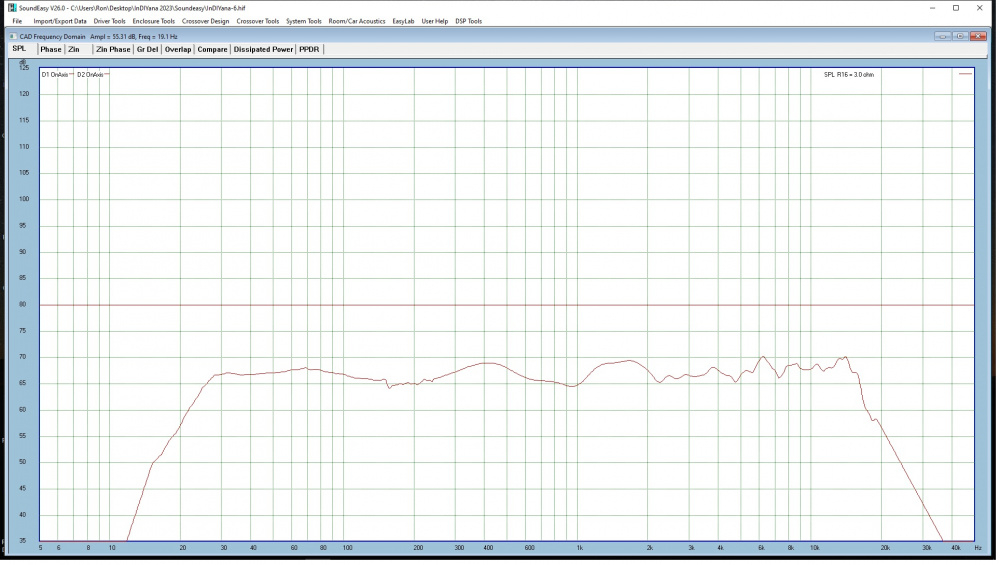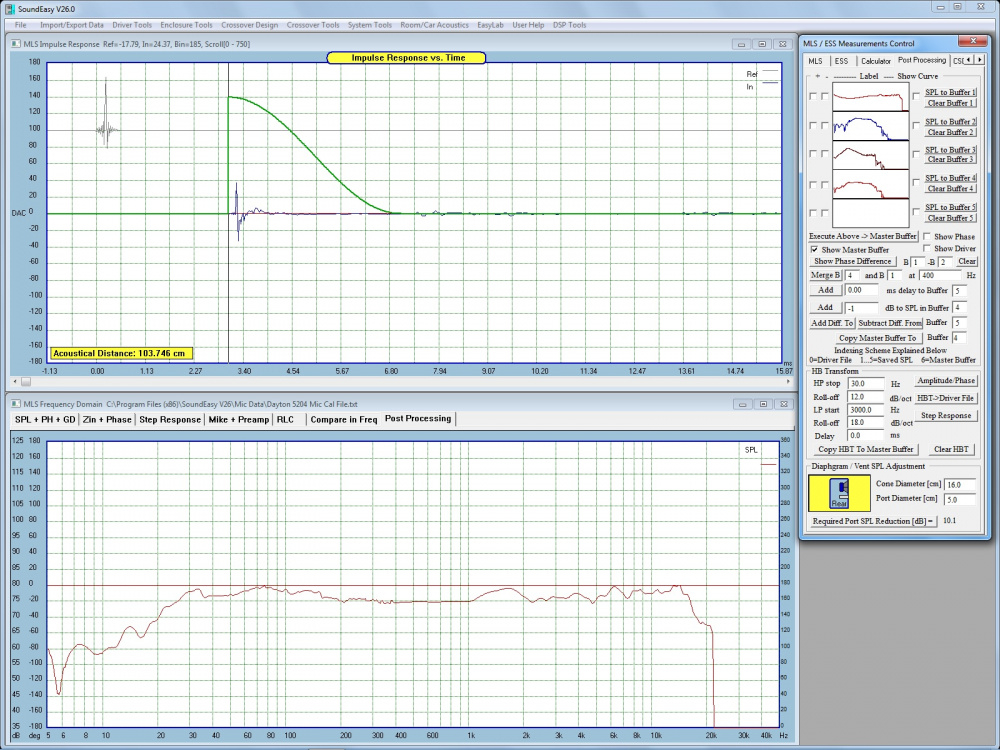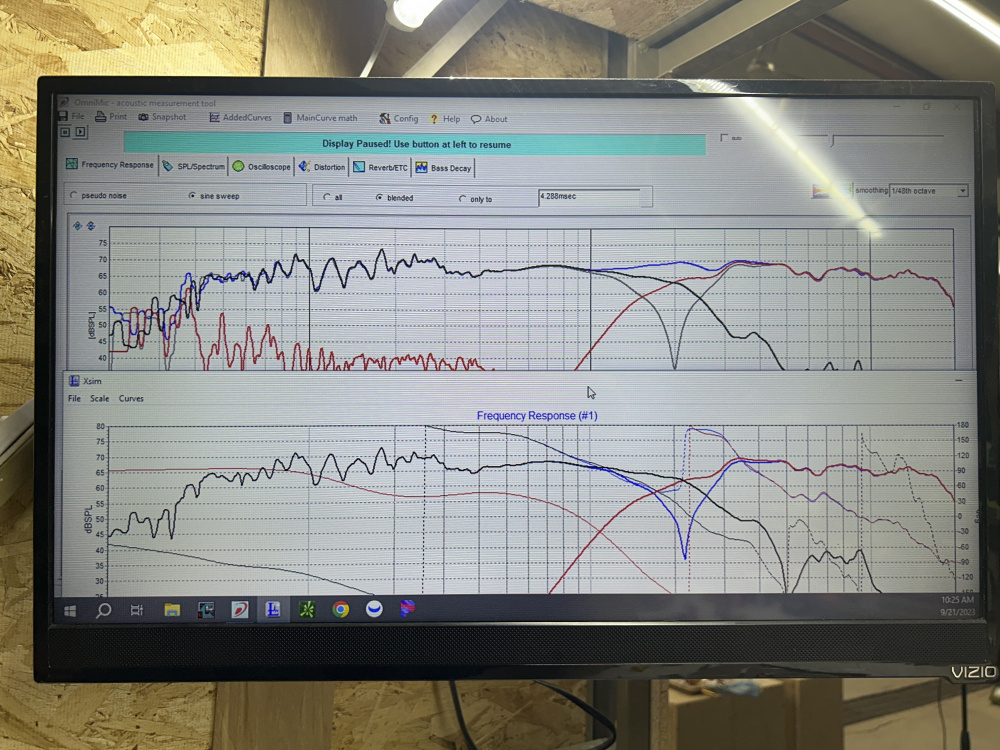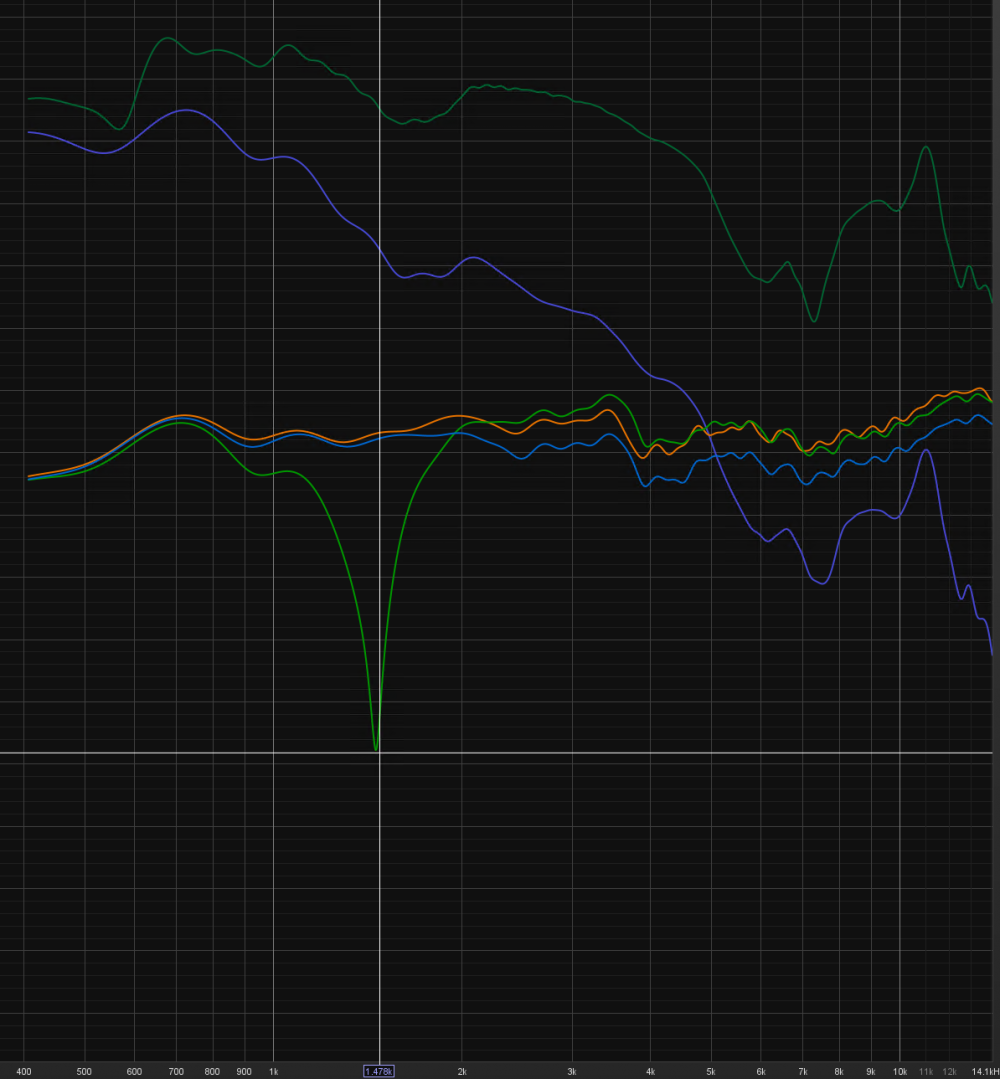Site Links
Howdy, Stranger!
It looks like you're new here. If you want to get involved, click one of these buttons!
Quick Links
Categories
In this Discussion
Who's Online (0)
Measurement and Modeling questions
I imagine there is some thread here somewhere, but it doesnt make itself apparent. Subject of the topic iteself vague and wide open, but here it was it stems from. There are numerous threads/guides out there, but so few gloss over the details or only cover a planned situation. Having experimented to learn from own trial and error as that is the best way to learn, I know there are tidbits I am missing to have the best success. So maybe i just list some bullet points to trigger ones own experiences.
1 - modeling in vitrix or xsim changing values seems to only vaguely reflect when change actual values then measure change of response via REW.
2 - how much does target box change anticipate driver response (more in mid and tweeter aspect). For instance, use a sb 4 inch mid, get a similar dip after 1.5k as manufacture specs but when export that frd and zma (have datsv3) into simulator, driver seems more ornery than specs graph and feel leads one to more excessive simulated xover design.
3 - working on a 3 way and ended up where 1st order high pass and 1st order low pass on the mid was giving me the best results. Typical 2nd order or greater designs were creating weird measurements while software sims telling me 1st order bad, mainly that create a phase dip around 12-14k, which might not be so audible to my ears these days. But more frustrating part is getting the curve 'pretty' in software yielded a 1600k xover point. Solder/clipped it up, but knew already that tweeter could get overbearing when handling that low, especially in a 3way where ideally wanna be in the 2-3.5k range. Hacked it up by hand with component shuffling and REW to observe changes and fell on the 1st order midrange - despite simulation telling me bad, summed measurements implied that all good. Reverse polarity give nice deep dips at 2k. So wish could just sit with someone in a day of measurement and design, would think something useful on that video site(utube). Only Speaker scott's were useful, others were half ass attempts just to say hey you will do this wrongs and then that it.

Comments
Traw - Where are you located physically upon this planet?
I feel your pain. I've got 6 builds under my belt and feel like I've barely got a clue what I'm doing. I've had great difficulty getting the sims to come even close to reality. So I just use the initial sim to get me in the ballpark (more like in the parking lot of the ballpark) and after that just use the sims to give me an idea how a certain part will differ from the current part I'm trying and that is about it. Still alot of trial and error and measuring over and over for hours. I just saved all the crossover parts that didn't work to start building a small inventory of stuff to try swapping out.
There are guys in this club that have a lot of experience and we all can learn from their tricks of the trade- and they are great at stepping up with advice. For me (still and always hopelessly a learner / experimenter- but its a fun way to get a handle on things) it has been a learning experience- run the sim, write down what each slight component value change does within the sim response and take it to actual measurements. Rinse and repeat. i.e. If you are looking for a way to slightly alter a slope of a filter, these guts will step up with a suggested component change. And building up the parts bin, if you are going to be in this hobby for awhile is a good thing.
The best advice I can give is not to be in a hurry for success - there is a lot to learn and understand and each little epiphany leads to the next one over time.
I knew when I got back into this hobby over 3 years ago that I wasn't going to get good results on my 1st or even 10 attempt at designing passive XO's.
I just stayed on the audio boards and read everyone's projects/discussion in order to learn the lingo and learned how to use XSIM functionally but finally realized that designing passive XO's was like trying to push a string uphill hoping it would go uphill . . . So I went into active XO's and have learned a lot more, more quickly as a result.
Taking measurements is the key but also an art-form in its own-right.
Just keep plugging away at it and try to relax while doing so - it takes time, reading, trial/error, experience over time to get it.
start with a single full range driver, take measurements, apply components to shape its sound then progress to a two way combo and grow from there.
You are describing what I first noticed about 10 years ago.
I'd measure a crossover, and it didn't agree (much) with the model.
As far as I understand the experts here, if you take a true dual channel measurement it works with simulation much better.
After all these years, I am still learning fundamentals!
Great to have quick response - knew this where the cool kids hung out heh. Ah this is what i suspected and much relieved that I'm not completely off the rails. Yep, about 6-8 builds and with most of them knowing that they are almost purely to learn. Messed around with active for 2-3 years, but that is also has own challenges and after falling into the rabbit hole, in my mind it is harder to gift active 2/3way speaker system.
So definitely have accumulated a mini stock pile of inductors, poly caps, electro caps and resistors to where almost intentionally order part here and there when buying something else, to fill in part selection for flexibility, knowing if were to hit a eureka moment that could 'upgrade' a part if reached the end (not exotic, more like get a 14-16ga air inductor vs a 20ga etc).
Anyway, did have the similar approach as mentioned to use models to get in the ballpark but then much more of tweak, measure change etc. Get the aligator clipped network meausing and sounding about right for 1 channel, make for the 2nd channel then listening and meh, time to rework the crossover heh. Experienced the trying to bend the curve too much where introduces a phase issue.
Anyway, yeah in the CBus area, did participate in the Dayton SDC 23 where speakers were built solely for the event to learn from and now just stacked in the basement heh. Moaned to 19year old, what do i do with all these - he says put them in my room then later realize his room cramped as is and he's was talking more to movie watching, bahhhh
Oh, but landing on 1st order to mid->tweet, 2nd order mid<-tweet of a 3way seemed to of solved my localized measurements, but trying to verify 'ok' in modeling, points that cone breakup makes a 10k dip. But real response of system seems to be very mild 2-3db at 15k where suspect would barely hear anyway.
Hmmm, just now as try to create screenshots to demonstrate, it seems there is more similarity of model vs reality than was complaining about. Though this 4 inch SB paper woofer, PE buyout that seems to be just sb nrx 4" paper giving me fits, the 1.5K step down where keep ending up with low 1.6k to look nice in models. But this sounded nicer than the initial xover. So this looks horrible in xsim, too easy not see likeness when REW scaled out vs this zoomed in

The step could be the first big baffle diffraction dip. I'd have a hard time believing that is a natural part of an SB 4" response. It may go away off-axis. A 4" like that aught to be able to handle more like 3khz crossover point.
Or if you still want to play around with the first order for now. Could try a zobel on the 4" to flatten out it's apparent impedance. That should help the first order low pass give more of a first order slope, since it wouldn't be fighting so much of an uphill battle.
I've done one 3-way sofar. It was very much of a hair tearing out process. Run into an issue that a value needs to change only to find it messes up something else when changed. Then have to start over from scratch again. Nearly swore off it.
Which build was yours at SDC, Traw? i sat in the front row, left of center.
InDIYana Event Website
The cheap SB have a cliff in their response that really complicates things. It looks like it is exacerbated by baffle signature.
I built a three-way in 2022 and the measurements with my mic were different from my sim in VituixCAD, mostly after 2khz. And changing component values did not do in reality what the simulation was predicting. I never quite figured out why and will re-measure all drivers and re-do my crossover to finalize before Christmas 2023 as these will be a gift. Light blue/teal is VituixCAD simulation, magenta is REW measurement with mic at 2 meters.
Every time there has been a difference it has been user error on my part. Two things that I know I did in the past: (1) individual driver measurement for xo design is at 1 meter. But software simulation is by default for 2 or 2.5 meters, so measuring actual speaker with xo in place needs to be at 2 or 2.5 meters. (2) Making sure I have accurate DCR on all of my inductors in the simulation - not a HUGE deal but in my 3 way I had 5 inductors and having inaccurate DCR can make small errors and 5 small errors can still make the actual measurement different than the sim.
Below is a two-way I brought to Detroit last weekend. Ignore below 250Hz as this one doesn't include merged low frequency. I'm always amazed at how good the simulation programs are, and almost all significant differences end up being user error on my part somewhere in the process.
@traw - over the years I have noticed many differences in crossover tweaking, including the same crossover measuring different on consecutive days - leading to me making my own alligator clip jumpers with 16G wire and soldered clips. And still I usually double up the clips when getting close to a solution. YYMV, but that is now my working crossover tweak method. Hope this helps.
I use SoundEasy for all my designs and my sims and measurement results almost always have good correlation. It's a dual channel measurement system and it has crossover optimization which I use exclusively for crossover design. I can adjust individual components on the fly and see the results but I find that the controls for that option aren't very good so I don't use it much. Where I see divergence from the sim and measurements generally occur in the crossover region. I'm not sure if that's from my measurements or it might be difference in mic placement between initial measurements and final measurements.
These are the sim and final measurements from my current project which was crossed at 800hz.
Sim

Actual

They look almost identical except the region between 200 and 1K. It looks like I merged the far field and nearfield at 400hz.
Ron
I always have to do it this way. I blow up xsim and put it right underneath Omni mic, and they usually look very similar. Checking the null here. My two senses good measurements. Make easy and consistent work later.

https://www.jfcomponents.com/
Actually got it to good measure point again, but not listen too yet as not like the low xover though using sb29 neo mag tweeter that 'handles' it, but not like that hearing the tweeter dominating or distortion/honk kick in at louder levels. Yeah, think my cylinder tube and stepped baffle could be creating some kind of diffraction issue as no matter get that 5db step down at 1.5k or so. Attaching pic of nearfield of mid green, purple nearfield (aware nf on 4" up to 4k ish) again with 1.25mh and 22-4.7uf 'zobel' (making look more like plain ole 2nd order). Calculated zobel was 10uf-4 ohm then swapped with values to see how model change rather than tunable block. Then orange of combined network, then green of reverse tweeter to check for deep null, yikes 1.5k. Then finally blue putting 1ohm before tweeter net.

I had the schmoo's (<300), where commented that had repurposed peerless tweets from zinger project heh. Thought had mid transition good on that one, but needed more bsc folded in to give some more warmth. They sound decent with lotsa detail but need a sub to mask the bass iffy ness on them. I sat too much in back where some kind of room modes made things bassy sitting back there. Tempted to revist schmoo putting epic7 in but prob better to just move one - and thus what I'm working on now with larger investment (satori 9.5 woofer, sb12nrx, sb29n tweet)
Will have to try 2m, most tweaking measure response change from component adjustments done in my smallish office where know reflections will cut my gated window down. Could only get up to 5ms or so in garage, need to setup something so can do in backyard but ended up with the distrust of my measurements even though was focusing just on the 400-500 up.
Wanted to go the CSS detroit event last weekend as prob more relaxed conversations, but I've been wearing down my wife's patience with the revitalized diy audio activities.
Time quit frittering this morning and crank out my day job work heh. rig up the other speaker and add the simple woofer net to see how sounds.
Okay, I know who you are now. You have a different moniker on PETT.
InDIYana Event Website
I think your first job is to raise the Fc for that tweeter!
That tweeter will play at 1500hz all day and not break a sweat.
Distortion plots will also show you very quickly if the tweeter is stressed.
ok, you guys are right....
Many moons ago Zaph had a design contest using the SB29 neo tweeter. Winners were:
Overall: LR4@ 1.6 KHz
Low Crossover: LR6 @ 1.1 KHz
Second Order: LR2 @ 2 KHz
Conservative: LR4 @ 1.8 KHz.
Harmonic distortion plots provided at 90, 100 and 110 db (zaphaudio.com/contest.html)
So yes, with the right crossover it can cross low.
I abandoned the sb12nrx mid, that 1.5k 4-5db drop down was making difficult. Plus wanted to see if other mid pointed that baffle creating issues.
Few iterations back had tried various series and parallel notches to pull down 1k but I didnt like that. I gave quick listen to that 1.5 xover with the SB mid, it was not to my liking sonically. Perhaps mental but i was listening to voices from the tweeter despite measurements looking ok. Plus my listening around smallish room.
So, stole the dayton sig4 mid from sdc project, much easier to work with. Some quick gated measurements since focused on the 500hz n greater anyway. I had actually bought the sb12 mid buyout (rebranded as aerial acoustics) same time i bought the sig4 and sig6.5 for SDC project. Landed at 2k LR2 for mid and 3rd order elect on tweet. Plus blended in the satori 9.5 and sounds about right now. Damn this woofer goes deep, tower is about 2cuft with 3" precision port x 10, dats shows me 29hz port tune. Feel like it "10inch 2 way" mid assisted
You have to tank the impedance peak to play the tweeter low.
JR, are you referring to the SB29 neo (SB29RDNC-C000-4) tweeter? That one doesn't have much of a peak; Re = 3.3 R, Zmax = ~ 7R).
I scrapped that cabinet, like others mention towers cumbersome to keep around and prefer stand mount in my primary listening area (home office). Also why been dabbling with coax's and small mids since tend to listen to a lot off axis, while working. So as Wolf/Ben has acquired some of those wavecor ceram-silk tweeters for his anamolies, some other night after some beverages heh, purchased set off ebay not realizing they in his project but will be good that can get to hear them as on the shelf at the moment while considering which direction to go. Funny, not realizing who the seller was (about 225 for the set), chuckled when I saw the return address on the package was Vance, guess I got the ones used for the audioexpress review.
Anyway.... after dabbling with some 2 way designs to get more practice, and aware of the helios. Though I know that around 1200-1300? crossover with a waveguide and beryllium. Is there a shot in hell of attempting 2way with Satori WO24 I have and the wavecor at 1500Hz? Easy to get voicing to liking with 2 way in smallish listening room.
Prob 3rd order on each side. Saw some inquiries on a FB group with varying opinions for how high to go with WO24 and looks like the wavecor more optimal at 2k ish. Though the look of the wavecor screams put me with sb ceramic.
I personally wouldn't go much past 1000 on the Satori, maybe 1200 depending on how third order distortion presents due to the serious breakup on the cone. Robust tweeter in a waveguide might be your best bet.
Think will just reuse the sb12cac and do as 3 way, chopped up mdf to make ~1.8cuft enclosure already (21 tall, 12 wide, 16.5 deep). Reuse 3" precision port (~10in), have some couplings around if need to adjust. Though I'm in no rush to finish these as they intended to be main speakers, so I tell myself for now.
One thing I observed/learned(?) with my other seas 3way (L12coax+titan7) is that simply using a PR interchangeable with a port, visa-versa, not true - thus need to learn, ask, read, experiment more. Seems the PR rolls off much quicker than port, giving up some F6/10. Output level seemed higher with port, things sounded much better when made a disc to fit the 8" PR hole and put a 2" port in. Still some tuning and prob throw another layer on back for appearance someday and switch to a flared port. Of course it more likely from my flawed box and driver modeling to begin with.